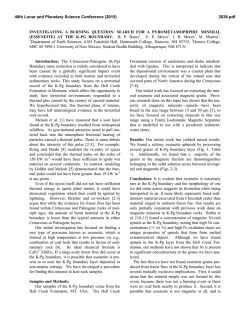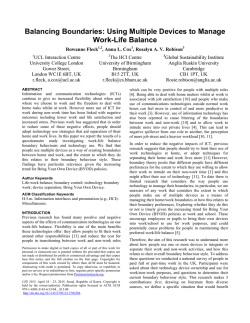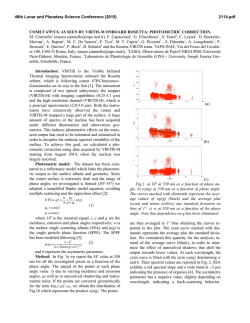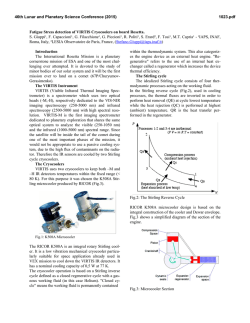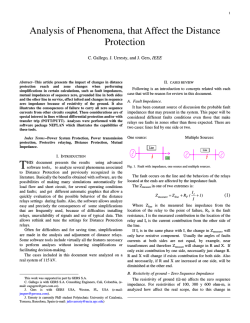
Link to Fulltext
SLAC-PUB-15231 Surface Impedance Formalism for a Metallic Beam Pipe with Small Corrugations G. Stupakov, K. L. F. Bane SLAC Abstract A metallic pipe with wall corrugations is of special interest in light of recent proposals to use such a pipe for the generation of terahertz radiation and for energy dechirping of electron bunches in free electron lasers. In this paper we calculate the surface impedance of a corrugated metal wall and show that it can be reduced to that of a thin layer with dielectric constant and magnetic permeability µ. We develop a technique for the calculation of these constants, given the geometrical parameters of the corrugations. We then calculate, for the specific case of a round metallic pipe with small corrugations, the frequency and strength of the resonant mode excited by a relativistic beam. Our analytical results are compared with numerical simulations, and are shown to agree well. Work supported by US Department of Energy contract DE-AC02-76SF00515. SLAC National Accelerator Laboratory, Menlo Park, CA 94025 I. INTRODUCTION Calculation of the impedance due to beam interaction with the walls of a vacuum chamber is an important part of the design of modern accelerators. In some cases the elements of the vacuum chamber that generate the beam impedance are small and uniformly distributed over the surface of the wall. One example of such an impedance is that due to surface roughness, which may be important, for example, in undulator vacuum chambers of modern x-ray free electron lasers [1–4]. Another example is a vacuum chamber surface with many small, approximately uniformly distributed holes [5, 6]. While exact calculation of the impedance in such cases can be extremely difficult or may even be impossible due to the smallness of the individual perturbations and their large number, the combined effect on the beam can often be represented by a so-called surface impedance. The situation here is analogous to the effective boundary condition introduced in electrodynamics when the skin depth in the metal (at a given frequency) is much smaller than the thickness of the metal wall and the wavelength of the electromagnetic field—the so-called Leontovich boundary condition [7]. In the accelerator context the surface impedance was previous employed by Balbekov for the treatment of small obstacles in a vacuum chamber [8, 9]. For a rough surface it was introduced by M. Dohlus [10] and also studied in [6]. The subject of this paper is how to use a surface impedance formalism to represent the beam-cavity interaction of a metal wall with small corrugations. A metallic pipe with wall corrugations is of special interest in light of recent proposals to use pipes with corrugated surfaces for the generation of terahertz radiation [11], and for energy dechirping of electron bunches in free electron lasers [12]. Following these papers, we will focus on the case of r b z FIG. 1. A round pipe of radius b with rectangular corrugations in the wall. 2 azimuthally symmetric, rectangular corrugations in a round pipe as shown in Fig 1. Note, however, that the surface impedance method of representing boundary corrugations is applicable more generally to geometries that are not round. This paper is organized as follows: In Section II we show how a corrugated wall can be replaced by an equivalent thin layer which has a dielectric constant and a magnetic permeability µ, and connect the values of and µ to the properties of the corrugations. While µ can easily be calculated for given parameters of the corrugations, finding requires the solution of a two-dimensional electrostatic problem. The solution to this problem is obtained in Section III. In Section IV we reformulate the boundary condition on the wall in the more general terms of a surface impedance. Using the derived boundary condition, in Section V, we calculate, for the case of a corrugated waveguide in round geometry, the frequency and strength of the resonant mode that is excited by a relativistic beam. In Section VI we compare the theoretical results with simulations, and in Section VII we discuss our main results. The derivation in the main text of the surface boundary conditions is somewhat intuitive in nature; in Appendix A we give a more formal derivation. Finally, in Appendix B we derive properties of the resonant mode in a round metallic pipe with a thin dielectricmagnetic liner. Throughout this paper we work in Gaussian units. II. METAL SURFACE WITH PERIODIC RECTANGULAR CORRUGATIONS We consider a metal surface with periodic corrugations of period p, depth h and width g. As was shown in [13], an electromagnetic field interacting with a small indentation in a metal wall induces electric and magnetic dipoles that are proportional to the strength of the electric field at the location of the indentation. Treating a corrugated wall as a sequence of indentations, we expect that it can be characterized by magnetic and electric moments per unit area. When the size of the corrugations is much smaller than the reduced wavelength of the electromagnetic field, λ = λ/2π, its electrodynamic properties can effectively be described by the averaged values of these moments. Since a thin layer which possesses dielectric and magnetic properties acquires electric and magnetic moments in an external electromagnetic field, we can equivalently replace the corrugations with such a layer, characterizing it by a dielectric constant and a magnetic permeability µ (see Fig. 2). In this 3 Section we will show how to connect the values of and µ to the geometrical shape of the corrugations. For our geometry, we expect the dielectric-magnetic model to be applicable when the corrugation period is much smaller than the reduced wavelength of the electromagnetic field, p λ. (1) In what follows, we will also assume that all dimensions of the corrugations are much smaller than the pipe radius b, p, h b, (2) which will allow us to treat the corrugated surface as locally flat. The coordinate y is y B p-g C y F D Ε ,Μ h x g A G FIG. 2. Corrugated surface and the equivalent dielectric-magnetic layer that replaces it in the effective boundary condition. perpendicular to the surface, directed to vacuum and is measured from the bottom of the corrugations, as shown in Fig. 2. We assume that the magnetic induction B0 is perpendicular to the plane x, y in Fig. 2 and, being tangential to the metal surface, freely penetrates between the corrugation teeth. The effective magnetic permeability µ of the equivalent layer is easy to find using the following argument. Consider the region 0 < y < h of the corrugations and calculate the volume averaged magnetic induction hBi in it. Because the magnetic field is expelled from the metal of the teeth, g hBi = B0 . p (3) For a magnetic layer with the magnetic permeability µ the relation between the tangential component of the magnetic induction in the layer Bl and the magnetic field Hl is Bl = µHl . 4 Due to continuity of vector H on the boundary between the layer and vacuum, it is equal to the magnetic induction B0 outside of the layer, Hl = B0 , and hence Bl = µB0 . The quantity Bl inside the layer is to be associated with the averaged value of the magnetic field hBi inside the corrugated area, Bl → hBi. Using (3) we then find that the effective permeability of the corrugated surface is equal to the fraction of the area not occupied by the metal g µ= . p (4) We see that µ does not depend on depth h; note also that µ < 1. To calculate the effective dielectric constant we need to find the electric field in the vicinity of (and inside) the corrugations. Due to the condition (1), in a small region near the wall, |x|, y λ, one can neglect the time dependence and consider the electric field as static, governed by an electrostatic potential φ(x, y), with E = −∇φ, which satisfies the Laplace equation. Compared to a flat metal surface where the boundary condition requires the electric field to be directed perpendicular to the surface, in case of corrugations, the electric field deviates from the normal direction at y ∼ h. At a large distance from the corrugated surface, however, where y h (but still y b), E is almost parallel to the ˆ . Mathematically it means that the electrostatic potential φ satisfies the y axis, E → E0 y boundary condition at infinity: φ → −E0 y + φ0 , when y → ∞. (5) The other boundary condition for φ is φ = 0 on the surface of the metal. The value of the constant φ0 in (5) is directly related to of the equivalent dielectric layer. Indeed, the electric field inside the dielectric layer is equal to E0 /, with E0 the normal electric field outside of the layer. Given φ = 0 at y = 0 we find that the potential drop in the layer is −hE0 / and hence the potential outside of the layer is φ = −hE0 / − E0 (y − h). Equating this expression to (5) we find 1− 1 φ0 = . hE0 (6) In the next Section we will show how to calculate φ0 using the conformal mapping technique, and thus express in terms of the geometric parameters g, h and p. Our main results equations (4) and (6) can be also derived in a more formal way from Maxwell’s equations. Such a derivation is given in Appendix A. 5 III. SOLVING THE LAPLACE EQUATION AND CALCULATING THE DIELEC- TRIC CONSTANT We need to solve the Laplace equation ∂ 2φ ∂ 2φ + = 0, ∂x2 ∂x2 (7) with the boundary condition φ = 0 on the surface of the metal and the asymptotic relation (5) at infinity. The function φ is periodic along x with the period p, and symmetric with respect to the vertical symmetry lines of the corrugation pattern (two such lines, AB and CD, are shown in Fig. 2). Given the symmetry of the boundary, it is sufficient to find the solution of (7) in the domain shown in Fig. 3. The boundary conditions for φ in this B C F D y A G x FIG. 3. The domain of solution of equation (7) is bounded by the red line (the letters along the line establish the correspondence with the area ABCDFG depicted in Fig. 2). Also shown is the local coordinate system x, y with the origin located at point A. domain are φ = 0 on lines AG, GF and FD (metal surfaces) and ∂φ/∂x = 0 on AB and CD (symmetry lines). One can find the solution of (7) in the domain shown in Fig. 3 with the help of the conformal mapping technique using the Schwartz-Christoffel integral [14]. For this we introduce the dimensionless complex variables w = ψ¯ + iφ¯ and z = y¯ + i¯ x, where x¯ = 2x , p y¯ = 2y , p 2φ φ¯ = − , pE0 (8) with x and y the local coordinates shown in Fig. 3, and ψ¯ an auxiliary function which we ¯ the asymptotic will not use in what follows. Note that with these definitions of y¯ and φ, 6 dependence (5) is cast into φ¯ = y¯ + φ¯0 with φ¯0 = −2φ0 /pE0 . The required conformal map, z = f (w), is defined by a complex analytical function f whose inverse, f −1 , gives the ¯ x, y¯) = Imf −1 (¯ normalized potential, φ(¯ y + i¯ x). Omitting the derivation, we present here the expression for f (w) [15]: s u−A B(A − 1) A−1 B(A − 1) 2 (B − A)F µ, + (1 − B)Π , µ, , f= π (A − B)(A − u) (A − B) A−B (A − B) (9) where u = 14 e−πw (1 + eπw )2 , and s µ = arcsin (A − B)(1 − u) (A − 1)(B − u) ! . (10) Here F (µ, τ ) is the elliptic integral of the first kind, Π(ξ, µ, τ ) is the incomplete elliptic integral of the third kind [16], and A and B (A < B) are numbers related to the geometric parameters p, g and h. These numbers are found from the following two equations: g Im lim f (w) = , w→A p Re lim f (w) = − w→A 2h . p (11) While the equation for f seems complicated, it can easily be solved with modern computational software programs such as Mathematica [17]. As a practical example we consider parameters of the corrugations considered in Ref. [12]: h = 0.45 mm, p = 1 mm, g = 0.75 mm. Solving equations (11) one finds A = 0.430, B = 0.965. Equipotential lines derived from Eq. (9) are shown in Fig. 4 and the dependence ¯ y ) at x¯ = 0 is shown in Fig. 5. One can see that as y¯ → ∞, the dependence φ(¯ ¯ y ) indeed φ(¯ approaches a linear profile φ¯ = y¯ + φ¯0 , in agreement with (5). The numerical value of the ¯ we find that constant φ¯0 = −0.7. Recalling the definition (8) of the normalized variable φ, φ0 /E0 p = 0.35 which gives for the value of in (6), = 4.5. The value of µ for this case is µ = g/p = 0.75. IV. SURFACE IMPEDANCE Having replaced the corrugations by a thin layer with dielectric and magnetic properties we can now derive an effective boundary condition on the surface of the metal due to the layer. For this we assume that the electric field in the system lies in the x, y plane and 7 1.4 1.2 2y/p 1.0 0.8 0.6 0.4 0.2 0.0 0.0 0.2 0.4 0.6 0.8 1.0 2x/p FIG. 4. Equipotential lines (blue) in a half-cell of the corrugations. 3.0 2.5 _ Φ 2.0 1.5 1.0 0.5 0.0 0 1 2 3 _ y FIG. 5. Dimensionless potential φ¯ versus y¯ for x = 0 (solid line). The broken line is φ¯ = y¯. The vertical distance between the two lines for large values of y¯ is equal to φ¯0 . the magnetic field is directed along z. We will also assume that all the fields depend on time and coordinate x through the factor e−iωt+ikx . These assumptions are adequate for calculation of the longitudinal impedance of a beam propagating along the axis of the pipe with a corrugated wall. 8 It follows from Maxwell’s equations that inside the layer Ex satisfies the following equation ω k 2 c2 −1 ∂Ex =i − µ Hz . (12) ∂y c ω2 Because the layer is thin, we can integrate this equation using the boundary condition on the surface of the metal, Ex |y=0 = 0, and assuming that the magnetic field is approximately constant within the layer, Ex |y=h ω ≈ ih c k 2 c2 −1 − µ Hz . ω2 (13) This relation can be considered as an effective boundary condition at y = h. If we now consider the axisymmetric geometry of the pipe shown in Fig. 1, and use the cylindrical coordinate system r, θ, z, then the boundary condition (13) is set at r = b−h ≡ a. Replacing the local components of the fields in (14) by the corresponding components in the cylindrical system, Ex → Ez and Hz → −Hθ , we arrive at the following boundary condition Ez |r=a = −ζHθ |r=a , where we have introduced the surface impedance ζ, ω k 2 c2 −1 −µ . ζ(ω, k) = ih c ω2 (14) (15) In the particular case of waves propagating with the speed of light along the axis of the pipe ω = kc, Eq. (15) simplifies to ζ = ih ω −1 −µ . c (16) In this form the expression for ζ was introduced in [6]. Note the similarity of (14) with the so-called Leontovich boundary condition on the surface of a good conductor [7] which for our case will have the same form as (14), but with p ζ = (1 − i) ω/8πσ, where σ is the conductivity of the metal. V. BEAM IMPEDANCE AND SYNCHRONOUS MODE Given the boundary condition (14) one can solve Maxwell’s equations for a relativistic beam propagating along the axis of the pipe and find the longitudinal impedance. This problem has been addressed in several papers in the past [6, 18–20]. Here we summarize the 9 main results of such analysis. For completeness, a detailed derivation of the resonant mode is given in Appendix B. A round pipe with a thin magnetic-dielectric layer supports the propagation of an axisymmetric mode with the phase velocity equal to the speed of light, i.e., ω = kc. The frequency of this mode ω0 is given by s ω0 = c 2 . ah(µ − −1 ) (17) Such a mode resonantly interacts with a relativistic beam and generates a wake field (for a point charge) equal to w(s) = 2κloss cos(ω0 s/c), (18) where κloss is the loss factor associated with the mode. In the lowest approximation the loss factor is given by (see derivation in Appendix B) κloss = 2 . a2 (19) The group velocity of the mode vg (an important parameter when considering the pipe as a terahertz source [11]) is close to the speed of light, and given by (see Appendix B) 1 − βg = 4 h µ − −1 , a (20) where βg ≡ vg /c. For completeness we should also mention that, because of the finite resistivity of the walls, resistive wall heating will accompany the mode. The analytical calculation of this effect can be found in Ref. [11] and will not be discussed further here. Note that an expression for the mode frequency obtained in Ref. [20] neglects the term −1 in (17) and is obtained from that equation in the limit −1 → 0, if one uses (4) for µ. As an illustration, we can now evaluate the frequency and the loss factor of the synchronous mode for a corrugated structure of Ref. [12]. The parameters are: h = 0.45 mm, p = 1 mm, g = 0.75 mm, b = 3.45 mm (and hence a = 3 mm). Taking = 4.5 and µ = 0.75 as calculated in the previous section and using (17) we find for the wavelength of the mode λ = 2πc/ω0 = 3.8 mm. Simulations reported in [12] give λ = 4.4 mm, in satisfactory agreement with our theory. Note that for this case the period p is actually larger than the reduced wavelength λ/2π, so a noticeable deviation of the analytical λ from the simulated one is not surprising. For the loss factor Eq. (19) predicts κloss = 1 MV/(nC·m) while the simulations give κloss = 1.36 MV/(nC·m). 10 VI. COMPARISON WITH SIMULATIONS To compare our analytical results with the direct solution of Maxwell’s equation we calculated the wavelength and the loss factors for several cases of small corrugations. All have the same values p = 1 mm, g = 0.75 mm and b = 3.45 mm, with h varying from 75 to 225 µm. Numerical results were obtained by running the computer code KN7C, a program that uses field matching to find the longitudinal modes in a periodic, disk-loaded structure [21]. Figure 6 compares the frequency of the resonant mode for five different values of h. There is good agreement between theory and simulation at larger values of h, with a discrepancy at the level of 10% for the smallest h. This is expected because the ratio λ/p decreases with decreasing h from 0.92 at h = 225 µm to 0.43 at h = 75 µm, and hence (1) is violated more at smaller h. æ 240 220 æ f (GHz) 200 180 æ æ 160 æ æ 140 120 æ æ æ æ 80 100 120 140 160 180 200 220 h (Μm) FIG. 6. Frequency of the resonant modes for five different values of h indicated by dots. Red color shows the theoretical values, blue color is simulations with KN7C. Figure 7 compares the theoretical and numerical loss factors. We see that the loss factor is more sensitive to the marginal fulfillment of condition (1); the theoretical result exceeds the simulated one by 30-40%. 11 2.0 Κ (MV/nC/m) 1.5 æ æ æ æ æ æ æ æ æ æ 1.0 0.5 0.0 80 100 120 140 160 180 200 220 h (Μm) FIG. 7. The dependence of the loss factors versus h. Red color shows the theoretical values computed with Eq. (19), blue color is simulations with KN7C. VII. DISCUSSION Our theoretical approach developed in Sections II and III can be generalized to other shapes of corrugations. While the magnetic permeability is easily calculated as a relative area of vacuum region in the corrugations, the electrostatic part of the problem involves the solution of Laplace’s equation for the given shape. For some shapes (for examples triangular corrugations) the solution can again be found with the help of the conformal mapping technique, while for more complicated shapes it can be found numerically. In any case, the derived values of µ and can then be substituted into the boundary condition (14) and (15) and used in the calculation of wakefields. One advantage of our theory is that it allows for direct comparison with metallic tubes lined with a thin dielectric layer, another approach for generating terahertz radiation [22]. Indeed, the main characteristic of the radiation—its frequency—is expressed by Eq. (17) through the effective values of and µ. For a pipe with wall corrugations these parameters are calculated as described in this paper, for the dielectric structure is just the electric permeability for the dielectric (e.g., = 3.8 for the fused silica used in [22]), and µ is typically close to 1. While our emphasis in this paper has been on pipes with round geometry, one can also 12 use the effective boundary condition (13) for pipes of different cross sections. As was pointed out in [12], for an adjustable dechirper, one can consider using parallel metallic plates with corrugations, which makes the cross section of the pipe rectangular. Electromagnetic propertied of such a structure were analyzed in Ref. [23] through a mode matching technique; the method developed in this paper offers an alternative, easier approach to the problem. VIII. ACKNOWLEDGEMENTS This work was supported by US DOE contracts DE-AC03-76SF00515. [1] K. L. F. Bane, C. K. Ng, and A. W. Chao, Estimate of the impedance due to wall surface roughness, Report SLAC-PUB-7514 (SLAC, 1997). [2] A. Novokhatski and A. Mosnier, in Proceedings of the 1997 Particle Accelerator Conference (IEEE, Piscataway, NJ, 1997) pp. 1661–1663. [3] G. V. Stupakov, Phys. Rev. ST Accel. Beams 1, 064401 (1998). [4] K. L. F. Bane and A. Novokhatskii, The Resonator impedance model of surface roughness applied to the LCLS parameters, Tech. Rep. SLAC-AP-117 (SLAC, 1999). [5] S. Petracca, Tech. Rep. CERN-SL-99-003, (CERN, 1999). [6] G. V. Stupakov, in Workshop on Instabilities of High Intensity Hadron Beams in Rings, AIP Conference Proceedings No. 496, edited by T. Roser and S. Y. Zhang (American Institute of Physics, Upton, New York, 1999) pp. 341–350. [7] L. D. Landau and E. M. Lifshitz, Electrodynamics of Continuous Media, 2nd ed., Course of Theoretical Physics, Vol. 8 (Pergamon, London, 1960) (Translated from the Russian). [8] V. I. Balbekov, On using equivalent circuits for calculation of longitudinal beam coupling impedance of a ring accelerator. I. A single insertion, (in Russian), Tech. Rep. IFVE-93-55 (Inst. for High Energy Physics, Protvino, Russia, 1993). [9] V. I. Balbekov, On using equivalent circuits for calculation of longitudinal beam coupling impedance of a ring accelerator. II. Symmetric system, (in Russian), Tech. Rep. IFVE-93-56 (Inst. for High Energy Physics, Protvino, Russia, 1993). [10] M. Dohlus, (1999), private communications. 13 [11] K. L. F. Bane and G. Stupakov, Nuclear Instruments and Methods in Physics Research Section A: Accelerators, Spectrometers, Detectors and Associated Equipment 677, 67 (2012). [12] K. Bane and G. Stupakov, Nuclear Instruments and Methods in Physics Research Section A: Accelerators, Spectrometers, Detectors and Associated Equipment 690, 106 (2012). [13] S. S. Kurennoy and G. V. Stupakov, Particle Accelerators 45, 95 (1994). [14] C. Ruel V and J. W. Brown, Complex variables and applications, 5th ed. (McGraw-Hill, 1989). [15] K. Bane and G. Stupakov, in Proceedings of the 28th International Free Electron Laser Conference (FEL 2006) (Edinburgh, UK, 2006) p. THPCH076. [16] F. W. J. Olver, D. W. Lozier, R. F. Boisvert, and C. W. Clark, eds., ”NIST Handbook of Mathematical Functions” (Cambridge University Press, 2010). [17] Wolfram Research, Inc., Mathematica, version 8.0 ed. (Wolfram Research, Inc., 2011). [18] A. V. Burov and A. V. Novokhatskii, The Device for Bunch Self-Focussing, Tech. Rep. BUDKERINP-90-28 (Budker Inst. of Nucl. Physics, Novosibirk, Russia, 1990). [19] K.-Y. Ng, Part. Accel. 25, 153 (1990). [20] K. Bane and G. Stupakov, in 20th International Linac Conference (Linac 2000), Vol. 1 (Monterey, California, 2000) pp. 92–94. [21] E. Keil, Nucl. Instr. Meth. 100, 419 (1972). [22] A. M. Cook et al., Phys. Rev. Lett. 103, 095003 (2009). [23] K. L. F. Bane and G. V. Stupakov, Phys. Rev. ST Accel. Beams 6, 024401 (2003). Appendix A: Formal derivation of boundary conditions We consider the plane geometry shown in Fig. 2 and assume the time dependence e−iωt for Ex , Ey and Hz , which are functions of x and y. Our goal is to solve Maxwell’s equations in the vicinity of the corrugations and obtain asymptotic expressions for the fields in the limit y h. Given condition (1) we consider the wave number k and the ratio ω/c (assumed of the same order), as small parameters in the theory, and put a formal smallness factor ς in front of them. This allows us to easily track the relative orders of magnitude of various terms in equations. In the final result we will set ς = 1. The two Maxwell equations for the electric field in vacuum which we need for the deriva14 tion are ω (∇ × E)z = iς Hz , c ∇ · E = 0. (A1) The equation for the magnetic field ∇ × H = −iςωE/c shows that the change in Hz is of the first order and since Hz enters into (A1) multiplied by the smallness parameter ς, account of its variation results in the second order terms which we neglect. Hence Hz can be considered as locally constant in the equations. At large distance from the corrugations, formally when y → ∞, the fields should match those in a wave traveling along x with wavenumber k. This requirement suggests the following form for the fields Hz = H0 eiςkx , ˆ × ∇χ)eiςkx , E = (−∇φ + ς z (A2) where φ(x, y) and χ(x, y) are periodic functions in x with the period p. Note that we assign the smallness parameter ς to the solenoidal part of the field in (A2) in comparison with the potential term −∇φ. We will see that equations support this scaling. Since we neglect variations of the magnetic field, H0 is a constant in our approximation. Substituting (A2) into ∇ · E = 0 we obtain ∇ · E = −eiςkx ∆φ − iςk ∂φ iςkx e + O(ς 2 ) = 0. ∂x (A3) In the lowest order approximation (A3) reduces to ∆φ = 0, (A4) with the boundary conditions φ = 0 at the surface of the metal and (5) at y → ∞. Substituting (A2) into the first equation in (A1) and neglecting second order terms we obtain ω ∂φ ∆χ = i Hz + ik . c ∂y (A5) The boundary condition for χ is the vanishing normal derivative, ∂χ/∂n = 0, at the surface of the metal. At large distance from the corrugations, y → ∞, the derivative −∂χ/∂y tends to a constant value equal to the electric field Ex induced by the corrugation. It turns out however that one does not need to solve (A5) in order to find the x component of the electric field Ex far from the corrugations. For this one needs to integrate (A5) over the vacuum 15 area Σ limited by the metal surface on one side and by a straight line y = y0 with y0 h on the other. We will assume that this area extends along x from x = 0 to x = l where l is equal to an integer number of periods, l = N p. We have Z Z ω dx dy + iklφy=y0 , ∆χdx dy = i Hz c Σ Σ (A6) where in the last term on the right hand side we used the boundary condition on the metal φ = 0 and took into account that at y = y0 according to (5) φ does not depend on x. Using Green’s identity, periodicity of χ along x, and the boundary condition ∂χ/∂n = 0 on the metal, it is easy to show that the integral on the left hand side of (A6) is equal to l∂χ/∂y|y=y0 = −(l/ς)Ex |y=y0 (Ex at large y does not depend on x). Also noting that the R area Σ dx dy = l[y0 − h(1 − g/p)] and φy=y0 = −y0 E0 + φ0 we obtain ω g −Ex |y=y0 = iς H0 y0 − h 1 − + iςk(−y0 E0 + φ0 ). (A7) c p Note that E0 and H0 , being fields in a plane electromagnetic wave, are related through E0 = kcH0 /ω casting (A7) into −Ex |y=y0 ω k 2 c2 g = iς H0 y0 1 − 2 − h 1 − + iςkφ0 . c ω p (A8) Eq. (A8) should be understood as a matching condition between the region near the corrugations and the field far from the wall. The value of y0 can be chosen arbitrarily in the region h y0 b. We can also treat (A8) as a formal boundary condition setting, for example, y0 = h. While this choice of y0 is inconsistent with the exact field distribution at y0 = h, considered as a boundary condition, it will correctly define the fields far from the corrugations. Setting y0 = h in (A8) and ς = 1 we obtain ω g k 2 c2 −Ex |y=h = ih H0 − 2 + ikφ0 . c p ω With a formal definition of and µ according to (4) and (6), Eq. (A9) reduces to ω k 2 c2 −1 −Ex |y=h = ih H0 µ − 2 , c ω (A9) (A10) in agreement with (14). Appendix B: Resonant modes in a pipe coated with dielectric-magnetic layer In this Appendix we study resonant modes propagating with the phase velocity equal to the speed of light in a round pipe coated with a thin layer which is characterized by a 16 dielectric constant and a magnetic permeability µ. We will assume a vacuum region at 0 < r < a and the layer at a < r < b with the layer thickness h = b − a a. The metal wall is located at r = b. We start from Maxwell’s equations in vacuum, ∇×H = 1 ∂E , c ∂t ∇×E =− 1 ∂H . c ∂t (B1) Assuming Eθ , Hr , Hz = 0, and all non-zero components of the fields ∝ e−iωt+ikz , we arrive at the wave equation for Ez 1 ∂ ∂Ez r + r ∂r ∂r ω2 2 − k Ez = 0. c2 (B2) The solution of (B2) in the region 0 < r < a is Ez = AJ0 (κr), with κ = p (B3) ω 2 /c2 − k 2 . For Hθ in vacuum we find c Hθ = −i ω −1 ∂Ez k 2 c2 ω −1 = −i AJ1 (κr). 2 ω ∂r κc (B4) Using (B3) and (B4) and the boundary condition (14) we arrive at the dispersion relation for the mode h J0 (κa) = κ ω2 2 −1 µ−k J1 (κa). c2 (B5) Note that for a resonant mode ω = kc and κ = 0. In this case one has to take the limit limκ→0 κ−1 J1 (κa) = a/2 on the right hand side of (B5) which gives the dispersion relation iωa ζ(ω, ω/c) = 1. 2c (B6) The solution to this equation ω = ω0 is given by (17). The electromagnetic field in the resonant mode can be shown to be (see, e.g., [6]) r Er = Hθ = E0 e−iω0 t+ikz , a Ez = E0 2i −iω0 t+ikz e , ka (B7) with E0 the wave amplitude. To find the loss factor κloss for the mode we will use the formula from [23], κloss = 2 Ez0 (1 − βg )−1 , 4u 17 (B8) where u is the electromagnetic energy per unit length in the mode, Ez0 is the amplitude of the longitudinal electric field on axis, and βg = vg /c, with vg = dω/dk the group velocity. The group velocity is computed by differentiating the dispersion relation (B5) which can be written as J0 (κa) = iω ζ(ω, k)J1 (κa). cκ (B9) The calculations are simplified if we note that we need the dispersion relation close to the point κ = 0 and expand (B9) assuming that κa 1: 1 J0 (κa) ≈ 1 − κ2 a2 , 4 J1 (κa) 1 1 ≈ − κ2 a2 , κa 2 16 (B10) 1 2 2 1 iωa 1 iωa ζ(ω, k) = κ a 1 − ζ(ω, k) . 1− 2 c 4 4 c (B11) and rewriting (B9) as Because the right hand side of this equation is of the second order in κa we can replace ζ(ω, k) there by ζ(ω, ω/c) which can then be eliminated with the help of (B6): 1 iωa 1 2 ω2 2 1− ζ(ω, k) = a −k . 2 c 8 c2 (B12) Differentiating (B12) with respect to k and setting in the result ω = ck we obtain 1 −h vg µ − c−1 = a (vg − c) . 4 (B13) Because we assume h small, vg on the left hand side can be replaced by c and the equation solved for vg , 1 − βg = 4 h µ − −1 . a (B14) From this solution we see that indeed vg is close to the speed of light. To calculate the energy in the mode u we use Eqs. (B7) in which we drop the exponential factor e−iω0 t+ikz , and set a unit field amplitude, E0 = 1, r Er0 = Hφ0 = , a Ez0 = 2ic . ω0 a (B15) To the lowest approximation the energy in the mode is computed by integrating the energy density in the vacuum region 1 u= 16π Z a 2 2πrdr(Er0 0 18 + 2 Hφ0 ) a2 = , 16 (B16) (an additional factor 1 2 in this equation comes from the averaging over time). Note that we neglected the Ez field in (B16) because it is much smaller than Er and Eφ . Substituting (B14) and (B16) into (B8) we obtain κloss = where we also used (17). 19 2 , a2 (B17)
© Copyright 2025
